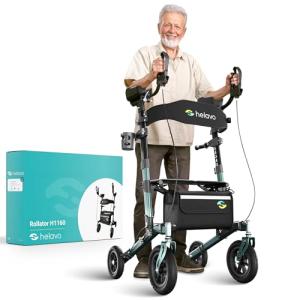12 Padded Seat Walker Facts To Get You Thinking About The Cooler Water Cooler

The Comprehensive Guide to Padded Seat Walkers: Comfort and Mobility Combined
Mobility challenges are a part of life for lots of individuals, whether due to age, injury, or numerous health conditions. As Handicapped Walker , the padded seat walker has emerged as a popular assistive gadget that not only aids in mobility however likewise provides a resting option. This guide will check out the features and benefits of padded seat walkers, some factors to consider for selecting one, and a lot more.
What is a Padded Seat Walker?
A padded seat walker, likewise known as a rolling walker or rollator, is a wheeled mobility aid equipped with a padded seat for resting. These gadgets generally have four wheels, handlebars, and a seat that allows users to browse their surroundings safely while supplying a spot to sit and recover when required. The walker is particularly advantageous for people who find themselves fatigued during extended walking or those who need additional support and stability.
Secret Features of Padded Seat Walkers
Here is a comprehensive list of crucial features to think about when picking a padded seat walker:
| Feature | Description |
|---|---|
| Padded Seat | Provides convenience during rest, often with back support to reduce sitting. |
| Wheels | Typically four wheels for stability and ease of motion, typically with locking systems. |
| Handles | Ergonomic and adjustable deals with that accommodate various user heights. |
| Brakes | Easy-to-use brake systems that boost security and control while walking or resting. |
| Storage Options | Often includes a basket or pouch to carry personal products firmly. |
| Lightweight Frame | Created for ease of transport and handling, generally made from aluminum or steel. |
| Portability | Some models fold for easy storage and transport, perfect for travel. |
Benefits of Using a Padded Seat Walker
A padded seat walker can significantly enhance the quality of life for users. Here are numerous advantages:
- Safety and Stability: A padded seat walker provides extra support, decreasing the risk of falls and injuries.
- Convenience: With a built-in seat, users can take breaks as needed without looking for a place to rest.
- Enhanced Mobility: Walkers encourage movement and expedition, promoting independence and encouraging a much healthier way of life.
- Convenience: Padded seats and ergonomic deals with are designed to provide comfort throughout use, reducing stress on the body.
- User-friendly: These walkers are typically easy to use with very little training, making them accessible for a broad range of users.
Selecting the Right Padded Seat Walker
When choosing a padded seat walker, consider the following aspects:
1. Size and Weight Capacity
It's important to pick a walker that accommodates the user's size and weight. Check the weight restricts defined by the maker and ensure the walker provides appropriate stability.
2. Adjustability
Search for designs with adjustable handles to personalize the walker height for comfort and security. This function is especially important for users of varying heights.
3. Seat Height and Comfort
Guarantee that the seat height is proper for the user. A comfortable padded seat with back support will improve the resting experience.
4. Wheel Type
Wheels can be found in numerous sizes and designs. Larger wheels may perform much better on uneven surface areas, while smaller wheels are simpler to maneuver inside.
5. Additional Features
Consider extras such as built-in storage, brake systems, and security features. More advanced models may include accessories like cup holders or back-rests.
How to Use a Padded Seat Walker
For optimum benefit and security, users need to be aware of proper strategies:
- Adjust the Walker: Set the walker to the proper height, guaranteeing that the user can easily grip the handlebars while standing directly.
- Test Mobility: Before stepping forward, users must guarantee the brakes are disengaged and the walker is stable.
- Keep Posture: Engage core muscles and maintain a straight posture while walking. The user should keep their weight focused over the walker.
- Take Breaks: If feeling fatigued, the user can stop, engage the brakes, and sit on the padded seat to rest.
- Shop Items Securely: Place personal possessions in the walker's storage compartment to avoid carrying extra weight.
Frequently Asked Questions (FAQ)
Q1: Who can gain from utilizing a padded seat walker?
A1: Padded seat walkers are beneficial for elderly people, those recuperating from surgical treatment, or anybody with mobility issues who requires support while walking.
Q2: How do I figure out which size walker to get?
A2: Consider the user's height and weight, and inspect the walker specs for weight limitations and size suggestions.
Q3: What is the typical life expectancy of a padded seat walker?
A3: With proper care and maintenance, padded seat walkers can last numerous years, typically between 5 to 10 years.
Q4: Can I use a padded seat walker outdoors?
A4: Yes, numerous padded seat walkers are appropriate for outdoor use, supplied they have adequate wheels developed for various surface areas.
Q5: How do I keep a padded seat walker?
A5: Regularly check the brakes and wheels for wear, tidy the frame, and guarantee that all parts are working properly for safety.
Last Thoughts
Padded seat walkers represent a vital resource in promoting self-reliance and mobility for those dealing with physical difficulties. By using convenience, stability, and safety, they assist enhance the lifestyle for users. If you or an enjoyed one are thinking about a padded seat walker, this thorough guide must assist in making an educated option. Embracing mobility aids can result in a satisfying and active way of life, proving that ease of motion is achievable at any age or condition.

